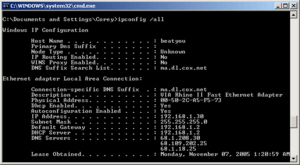ipconfig

In computing, ipconfig (internet protocol configuration) in Microsoft Windows is a console application that displays all current TCP/IP network configuration values and can modify Dynamic Host Configuration Protocol (DHCP) and Domain Name System (DNS) settings.[1]
In most cases, the ipconfig command is used with the command-line switch /all. This results in more detailed information than ipconfig alone.[2]
Forced release and renew
An important additional feature of ipconfig is to force refreshing of the DHCP IP address of the host computer to request a different IP address. This is done using two commands in sequence. First, ipconfig /release is executed to force the client to immediately give up its lease by sending the server a DHCP release notification which updates the server's status information and marks the old client's IP address as "available". Then, the command ipconfig /renew is executed to request a new IP address.[3][4] Where a computer is connected to a cable or DSL modem, it may have to be plugged directly into the modem network port to bypass the router, before using ipconfig /release and turning off the power for a period of time, to ensure that the old IP address is taken by another computer.[5]
The /flushdns parameter can be used to clear the Domain Name System (DNS) cache to ensure future requests use fresh DNS information by forcing hostnames to be resolved again from scratch.[6]
Mac OS X ipconfig
ipconfig in Mac OS X serves as a wrapper to the IPConfiguration agent, and can be used to control the BootP and DHCP client from the command-line interface.[7] Like most UNIX-based operating systems, Mac OS X also uses ifconfig for more direct control over network interfaces, such as configuring static IP addresses.
References
- ↑ Microsoft Windows XP ipconfig support page
- ↑ "What is ipconfig command ? and how to use it". www.mbgadget.com. Retrieved 2016-12-02.
- ↑ Release and Renew Your IP Address
- ↑ Windows – Displaying, Releasing and Renewing a DHCP Lease
- ↑ whatsmyipaddress: How to change your IP address
- ↑ Windows 8.1 PCs Connect to the Network but not the Internet
- ↑ OS X developer manual
External links
- Windows
- Mac OS X